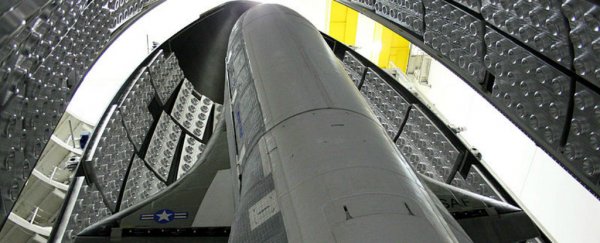The Russian military has announced that it's in the process of building a space plane that could fire weapons anywhere on Earth within two hours… and it's going to be armed with nukes.
According to the Daily Beast, the claims could kick-start a new nuclear arms race between the US and Russia - but this time in space.
Russia's military told the state-owned news site Sputnik this week that they're making good progress on a bomber, which will be able to launch nuclear warheads from outer space, and could be ready as early as 2020.
The plane itself is similar to the US Air Force's reusable Boeing X-37 (X-37B) robotic mini-shuttle, which is sort of like a miniature, remote-controlled version of the International Space Station.
In itself, that's not a bad thing - many companies and governments are working on similar planes themselves.
But now Russia has announced that they plan to store nuclear warheads in their robotic plane.
"The idea is that the bomber will take off from a normal home airfield to patrol Russian airspace," Lieutenant Colonel Aleksei Solodovnikov told Russia's International News Agency, as Sputnik reports. "Upon command it will ascend into outer space, strike a target with nuclear warheads and then return to its home base."
Not cool, guys, not cool.
"That's not only a gross violation of international law, it represents a fairly profound act of hypocrisy on Russia's part," writes David Axe for the Daily Beast.
"It wasn't long ago that the Russian government accused the United States of weaponising space by sending aloft the nimble, versatile X-37B, basically a quarter-size, remote-controlled version of the Space Shuttle that could, in theory, carry weapons - but does not."
The accusation he's referring to was made in April 2010, when the US Air Force launched the X-37B for the first time, and the Russian military accused them of sneaking weapons on board, breaching the Outer Space Treaty.
The treaty was signed back in 1967 by 104 countries, including the US and Russia, and it banned the militarisation of space.
The treaty states: "parties to the treaty undertake not to place in orbit around the Earth any objects carrying nuclear weapons or any other kinds of weapons of mass destruction, install such weapons on celestial bodies or station such weapons in outer space in any other manner."
The US's X-37B was assessed by independent experts and deemed too small to carry weapons that could strike Earth, so that crisis was averted.
But six years later, Russia is outright claiming they're developing technology that will be able to do just what they agreed not to when they signed the treaty. In fact, that's the craft's sole purpose.
To be clear, right now the only confirmation we have about this nuclear space bomber is from state-controlled Russian media, so let's not get too carried away. But if it's true, it's a pretty concerning development for the tenuous relations between Russia and the rest of the world.
So how does the plane work? Again, details are pretty thin on the ground, but from what we know so far, it seems like the bomber could be similar to Virgin's space planes, which 'piggyback' on a transport plane until blasting off into orbit.
The Russian craft might also be able to launch by itself. But that would require an engine that can work in two ways: first burning liquid propellant to launch, and then being able to 'breathe' oxygen as fuel in order to reach supersonic speeds, similar to a SABRE engine.
An engine that can do both these things, known as a combined-cycle engine, is something the US government has been working on for decades, but at the end of last year, a Russian official claimed the Kremlin had managed to do it.
"We have accomplished the task of developing a powerplant for a plane that allows it to alternate between the air-breathing regime during a flight in the atmosphere and rocket propulsion regime during a flight in space," an anonymous official from the Strategic Missile Forces Academy told reporters in October 2015.
What we do know is that the plane will be big. "I think that its lift-off mass must be 20-25 metric tonnes for it to be a strike aircraft," Solodovnikov told Sputnik. "It will [be able to accelerate to] hypersonic speed in rocket mode."
According to Sputnik, the engine for this nuclear space bomber is expected to be showcased at the Army-2016 International Military Technology Forum near Moscow in September, so hopefully we'll find out more then.
In the meantime, let's hope this news isn't as bad as it currently sounds.
And while we all contemplate the possibility of nuclear war from above, let's just enjoy this Saturday Night Live comparison of Obama and Putin (because if you don't laugh, you'll probably cry):

